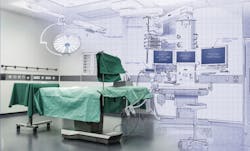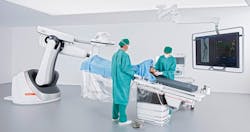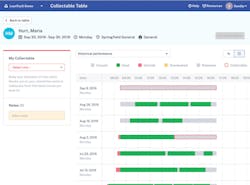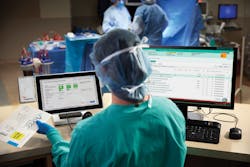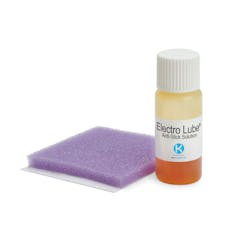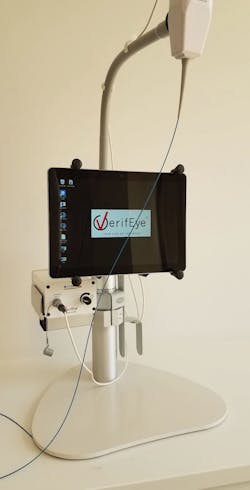Surgical suites are some of the most advanced areas of healthcare, with health systems and hospitals investing significant resources to support growing volumes of more advanced surgeries. In this article, HPN highlights the products, services and technologies shaping and upgrading patient care delivery in the operating room (OR) to make it safe, efficient and staff-friendly.
Surgical suite design
Building a new surgical suite, or renovating an existing one, can be a complex and costly endeavor. Every choice – from the layout of the space to the medical equipment, lighting and connectivity – has an impact on patient care, workflow, clinical satisfaction and safety.
“Providing a good quality of care is the primary objective of any healthcare facility,” said David Schicht, Senior Marketing Manager, Workplace Infrastructure, Dräger. “Quality of care issues in hospitals have been linked to many aspects of design: From poor room design, a lack of ergonomics, high noise levels or long distances from nursing units to patient rooms. A well-designed healthcare workplace and environment can result in considerable improvements in clinical outcomes, economic performance and productivity, as well as patient and staff satisfaction.”
Dräger’s Healthcare Design Center in Telford, PA, features a mini-hospital – including an emergency department, OR, intensive care units, neonatal care unit, and long-term acuity care unit – where hospital planners, clinicians and other stakeholders can create an ideal workspace, and experience it first-hand.
Working with the Dräger design team, the healthcare facility’s multi-disciplinary team (e.g. medical users, planners, architects) capture their ideas for the new or redesigned care area, which the Dräger team uses to design a virtual space with a 3D modeling tool. Within this tool, they can test out different possibilities and make changes.
Once an optimal design is established, the Dräger team physically builds out the space with the selected equipment, so the healthcare facility’s team members can touch/feel it and make modifications.
“When designing a new surgical suite, a facility should plan for more space than it initially believes it needs because technology is continuously evolving,” said Schicht. “Trends such as medical robotics, mixed reality should be considered during the planning stages, not just to accommodate their use but also to plan for workflow, infection prevention and patient outcome considerations related to these emerging technologies.”
Designing the hybrid OR
Designing a hybrid OR presents its own unique challenges in terms of space and workflow with the integration of imaging technologies to support minimally-invasive procedures. Healthcare facilities allocate significant resources in these spaces, so they want to ensure they get the most out of their investments.
“Hospitals are doing a much better job of maximizing their return on investment in their hybrid ORs by making sure they are building them to be capable of a wide range of both open and minimally-invasive procedures,” said Joe Riley, VP of Interventional Radiology and Cardiology at Siemens Healthineers North America.
Riley points to a hospital in Houston with multiple hybrid ORs that are designed to treat trauma patients in emergent situations, such as internal bleeding in the head or abdomen. Rather than having to send the patient to a separate area for diagnostic imaging to assess the location and severity of the bleed, and then to an OR for surgery, everything can now be performed in a single hybrid OR.
“Being able to treat trauma patients all in one suite drives high-level care,” said Riley. “As soon as the patient presents, the clinicians can diagnose and treat that patient instantly in the hybrid OR with access to open or minimally invasive techniques because they have advanced imaging in the room along with full surgical capabilities.”
Riley explains that the challenge in this case is having fixed imaging technology that allows for effective clinical workflow in the limited hybrid OR space. Traditional C-arms are either ceiling mounted, which move over the patient’s sterile field, or floor mounted, which take up valuable space.
The ARTIS pheno, a robotic C-arm angiography system from Siemens Healthineers, is designed specifically to maximize capabilities and efficiency in the hybrid OR. The robotic ARTIS pheno can be unobtrusively moved into and out of the surgical area. This allows optimal patient access across patient types—from pediatric to bariatric—while providing the access surgical and anesthesia teams need to make complex interventions easier.
With seamless covers, antimicrobial surfaces, sealed tableside modules, and an uninterrupted airflow due to no ceiling-mounted components, the ARTIS pheno makes system cleaning easier, which can reduce the risk of infection and improve safety for patients.
“If you are designing an innovative surgical suite where you want hybrid capabilities, the ARTIS pheno offers great flexibility in terms of procedural workflow, table options and advanced imaging capabilities,” said Riley.
Maximizing surgical suite utilization
Surgical services are a main revenue driver for healthcare facilities; therefore, it is critical to maximize this asset to its fullest potential. Ashley Walsh, Senior Director, Client Services for LeanTaaS, says leading surgical suites across the nation are adopting a data-driven approach to unlock OR capacity so that more cases can be performed in the same number of ORs without extending business hours.
“Using predictive analytics, machine learning, and web and mobile technologies, perioperative leaders can engage surgeons with credible performance metrics, and collect and make available the right set of underutilized blocks to surgeons needing more time or to attract new surgeons,” said Walsh.
The LeanTaaS iQueue for Operating Rooms solution digitally transforms core operational processes in ORs through three modules:
- Exchange identifies and exposes the available inventory of open time through an “OpenTable”-like tool. Surgeons and clinics can easily discover and request time with a single click from any mobile or desktop browser.
- Collect mines OR usage data by block owner, surgeon and service line to identify repurposable chunks of time. With this actionable guidance, perioperative leaders can redistribute underutilized blocks to new or existing surgeons without impacting existing case volume.
- Analyze monitors OR performance and helps surgeons and administrators be more proactive and productive by sending timely mobile alerts about OR volumes, efficiency metrics and opportunities for improvement to help increase the speed in which decisions are made to improve efficiencies.
“A 1 percent improvement in OR utilization can mean as much as $500,000(+) in additional revenue per year per OR,” said Walsh. “Our customers typically see from 3-6 percent improvement in OR utilization system-wide. The solution also increases patient access to the OR: Duke Health has been able to complete eight additional elective cases during each business day.”
Taking a portable approach
In most healthcare facilities, the surgical suite is used for a wide variety of procedures, resulting in competition for this valuable, but typically limited space. As Richard Shaul, Vice President of Marketing, Orthoscan, explains, transcatheter aortic valve replacement (TAVR) procedures are usually performed in a Cath lab near OR space with a specific OR room allocated to these procedures to accommodate emergency issues resulting from TAVR.
“When this OR space goes unused, it can cost the hospital thousands of dollars per day in lost revenue,” said Shaul.
Orthoscan has partnered with Ziehm Imaging to reshape the TAVR landscape by integrating Orthoscan’s portable lab within the surgical suite.
“Today we work with facilities to implement our solution, a portable Cath lab, within the OR space itself,” said Shaul. “With detail imaging and lower dose, we can outperform all other hybrids. By having a truly portable solution, we are in the OR space for TAVR but if there is an issue and further action needs to be taken, our system simply and quickly moves completely out of the way, allowing physicians to access the patient immediately. The cost effectiveness of our solution coupled with ease of use allows Ziehm to begin to shape the space surrounding TAVR and endovascular aneurysm repair (EVAR) for hospitals of any size.”
Engaging a virtual team
As surgical procedures become more complex, they require the engagement of multiple clinical stakeholders, adding to the challenge of limited OR space. In most cases, today’s surgical suites simply can’t accommodate the number of people who may be called upon to provide their expertise during a case.
For example, Kelly Fitzgerald, Marketing Director, Systems Integration and Infrastructure, Medical Systems Group, Olympus Corporation of the Americas, notes the growing trend toward imaging-heavy, minimally-invasive, multi-disciplinary procedures performed by a team of surgeons, cardiologists, anesthesiologists, nurses, radiology technologists and surgical scrub techs.
“These types of surgeries require more complex systems and equipment in the OR and often lead to manufacturer’s reps and/or a Biomed in the procedure room to help train or assist staff in the proper use of the new equipment,” said Fitzgerald. “When you add students and residents in the procedure room space to observe and learn, and then the ad-hoc intraoperative consults with a senior clinician or specialist, the room quickly becomes overcrowded with additional concerns regarding the security of sterile areas, strict infection control and protecting the patient’s privacy. Surgical site infections (SSIs) contribute the most to the overall costs of healthcare acquired infections (HAIs).1,2
To address this issue, Olympus has developed the MedPresence immersive medical virtual presence solution, which enables teams to bring needed expertise quickly – specialists, senior clinicians, technical experts, application trainers or manufacturer’s representatives – into a procedure space from across the organization, around the world, and at any time – virtually. The solution incorporates not only the standard sources of collaboration today (e.g. chat and audio), but also specialized views – room view, customizable task views (e.g. the surgeon’s hands), access to web-based applications, and, most importantly, access to a variety of live clinical imaging sources.
“By leveraging virtual experts, MedPresence can first and foremost help elevate the care team’s expertise,” said Fitzgerald. “However, there are additional benefits, including protecting the patient care environment by reducing room crowding, eliminating security and access concerns and lowering a patient’s infection risk.”
“Another is helping students be immersed virtually in surgery to understand the level of communication competency required to be part of a high-functioning team collaborating clearly with physicians, nurses and specialists,” Fitzgerald added.
Streamlining supply management
According to Jeff Porubcansky, VP of Customer Operations, WaveMark Supply Management & Workflow Solutions, Cardinal Health, Meaningful Use criteria are driving hospitals to adopt and grow their technology footprint at a rapid rate. As a result, clinicians are experiencing burnout as they strive to use disparate systems to accurately document data for patient records.
“More than ever, clinicians need support to streamline and optimize their workflows and documentation in the operating room,” said Porubcansky. “Because of this, surgical suites are beginning to leverage supply automation technology that integrates with their existing IT and electronic health record (EHR) systems. This new technology allows clinicians to capture product usage data quickly and accurately, helping them to get back to what matters most – taking care of their patients.”
Cardinal Health’s WaveMark Supply Management & Workflow Solutions optimize clinician workflows by eliminating manual data entry during clinical documentation. WaveMark reduces the time it takes to manage and retrieve products by telling clinicians exactly where to find the product they need. The solution supports Meaningful Use documentation requirements via optimized workflows at the point of use, automatically collecting and distributing product usage details to all interfaced systems and patient records.
“WaveMark helps clinical teams focus on patient care because there are fewer redundancies and opportunity for error,” said Porubcansky. “By automating clinical documentation tasks, WaveMark eliminates the need for manual data entry – reducing clinical burnout and freeing up staff time. The increased operational efficiency supports improved clinical outcomes by giving caregivers more time, allowing them to work at the top of their licensure and spend more time focusing on their patients.”
Improving the efficiency and safety of electrosurgical procedures
“2020, ‘The year of the Nurse and Midwife’ affectionately named in honor of the 200th birthday of Florence Nightingale,3 is also proving to be the year of electrosurgery, robotics, artificial intelligence and minimally-invasive surgery,” said Michelle Lemmons, Operating Room Clinical Educator, Key Surgical. “Recent research is revealing that minimally-invasive surgery is reducing cost (versus open surgery), reducing complications after surgery, reducing risk of readmission, and reducing the time it takes for patients to return to work and normal activities. More facilities are installing robotic surgical equipment (1.8% to 15.1% from 2012 to 2018)4 and research is quickly building to further optimize these minimally-invasive interventions.”
Keeping surgical equipment safe and effective
As surgical procedures become more advanced, the medical devices used to perform them become more complex. Devices featuring lumens are particularly challenging to clean and inspect for internal damage. To effectively reprocess these instruments, central sterile/sterile processing departments (CS/SPD) professionals need advanced technologies of their own that allow them to visually validate that they are both clean and intact before they reach the surgical suite.
“The VerifEye Video Borescope provides the ability to visually validate internal damage and cleanliness of lumens,” said Matt Ofenloch, CSPDT, Device Implementation and Business Development Manager, STERIS Instrument Management Services. “When damage and/or residual bioburden is identified, corrective action can be taken before the next procedure ensuring patient safety. The VerifEye Video Borescope can identify damage before it becomes severe, which prevents damaged equipment from being used on a patient. The VerifEye Video Borescope provides the opportunity to validate cleanliness of lumens reducing undesirable outcomes in facilities.”
References
1. Priscilla Perez, Julia Holloway, Lucy Ehrenfeld, Susan Cohen MT(ASCP)SM, Linda Cunningham RN, Gerald B. Miley MD, Brian L. Hollenbeck MD, Door openings in the operating room are associated with increased environmental contamination.
2. Zimlichman E, Henderson D, Tamir O, et al. Health Care-Associated Infections: A Meta-analysis of Costs and Financial Impact on the US Health Care System. JAMA Intern Med. 2013;173(22):2039–2046. DOI:10.1001/jamainternmed.2013.9763 | https://jamanetwork.com/journals/jamainternalmedicine/fullarticle/1733452
3. https://ilc-congress.eu/activities/2020-year-of-the-nurse/
4. Sheetz, Kyle H. “Trends in the Adoption of Robotic Surgery for Common Surgical Procedures.” JAMA Network Open, American Medical Association, 10 Jan. 2020, jamanetwork.com/journals/jamanetworkopen/fullarticle/2758472.
5. Baker, Jeffrey C, and Hassan H Ramadan. “The Effects of an Antistick Phospholipid Solution on Pediatric Electrocautery Adenoidectomy.” ENT Journal, vol. 91, no. 1, Jan. 2012, http://www.electrolubesurgical.com/wp-content/uploads/eagle_surgical_litterature.pdf.
6. Brill, Andrew I. “Electrosurgery: Principles and Practice to Reduce Risk and Maximize Efficacy.” Obstetrics and Gynecology Clinics of North America, vol. 38, no. 4, 2011, pp. 687–702., doi:10.1016/j.ogc.2011.09.005.
7. Roy, Sudeep, et al. “The Effects of an Antistick Phospholipid Solution on Bipolar Electrocautery Efficacy in Rhytidectomy.” The American Journal of Cosmetic Surgery, vol. 34, no. 3, 2017, pp. 156–160., doi:10.1177/0748806817698291.
About the Author
Kara Nadeau
Senior Contributing Editor
Kara Nadeau is Sterile Processing Editor for Healthcare Purchasing News.

